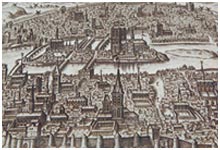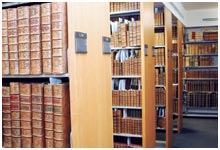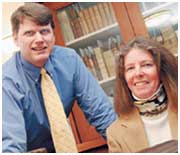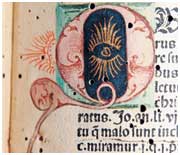|

As The George Washington University Law School continues to make tremendous strides by building physical structures for the future, the Jacob Burns Law Library is investing in the future of the institution by looking to the law's past. Along with computers, new furniture, and books on such innovative topics as Internet law, the law library has made some exciting recent purchases that will enhance its reputation as one of the leading academic research libraries in the country.
The tradition of acquiring entire collections has been an important element in the development of great libraries and, in particular, great law libraries.
|
There are different types of academic law libraries. Whereas many maintain only a very basic collection of cases and statutes, those institutions that seek to meet the research needs of a large, active faculty and attract students from around the world must sustain unique collections of materials that could not be obtained through interlibrary loan or found on the Internet.
The Jacob Burns Law Library, always one of the largest law libraries in the United States, reinforced its commitment to developing a collection of the highest quality when it became a member of the prestigious Research Libraries Group in 2001. As a member of this elite group, the library seeks to obtain materials needed not only by its current faculty and students, but also by future generations of researchers who would be drawn to the institution by its collections.
Since 2001, the Burns staff has had several unique opportunities to enhance its collection beyond its greatest expectations. The first of these opportunities took place when the collection of the Birmingham Law Library was auctioned in London, and GW Law was able to obtain hundreds of important early works on legal history. GW also acquired a collection of 19th-century codes from the Library of the Faculty of Procurators in Glasgow, Scotland.
However, the most significant event took place during the spring of 2002 when the entire collection of a noted French attorney and official of the late 18th century, Pierre Theodore du Payrat, was auctioned in Paris. Acting through an agent, the Burns Law Library was able to acquire 90 percent of the collection—2,000 volumes of rare and important works on legal history dating back to the 16th century, including an important collection of early French costumes (collections of regional customary law).
The tradition of acquiring entire collections has been an important element in the development of great libraries and, in particular, great law libraries. In 1815 Congress purchased Thomas Jefferson's entire collection as the foundation for the present Library of Congress. The Harvard Law School Library has developed its holdings of rare books in this fashion, purchasing the international law collection of the Marquis de Olivart in 1912, the Dunn collection of early English law books in 1913, and the Viollet French legal history collection in 1921. In more recent times, The George Washington University was able to acquire the collection of the Carnegie Endowment for International Peace, thereby obtaining an invaluable array of international materials.

A woodcut from the title page of Les Edicts et Ordonnances des Rois de France depuis Louys VI, dit le Gros (1611) offering a bird's-eye view of Paris. A volume from the library of Pierre du Payrat.

Some of the more than 2,000 volumes dating back to the mid-16th century from the library of Pierre du Payrat, acquired by the Burns Law Library in 2002, provide invaluable historical information on French, Roman, and Canon Law.
|
Of course, no law library can hope to collect in all fields of research. The staff of the Jacob Burns Law Library has focused its acquisitions efforts on areas that are likely to attract scholars based on current research interests of faculty members. The decision to focus on French materials came, in part, from the interests of two faculty members, Renee Lettow Lerner and Richard Cummins. Another area of collection development, the interaction between church and state, is the focus of research and writing by a number of faculty members at the Law School. Some of the rarest materials acquired, therefore, speak to both of these issues, and the turbulent history of church-state relations in France is well represented in the library's collection.
One book of particular interest from the collection is the Songe du Vergier, printed in 1500. Written at the behest of Charles V in the 14th century in an effort to reinforce the notion of the sovereignty of the king, this amazing book comprises a dialog between a knight and a member of the clergy regarding the duty owed to the church and to the state. Also in the library's collection are several early volumes, including one printed in 1497, which discuss the Pragmatic Sanction of Charles VII, a controversial document through which French kings were granted powers normally reserved for the church.
In addition, the library staff has acquired the writings of many controversial individuals from the period of religious strife during the 16th and 17th centuries, including those of Francois Hotman, a Huguenot attorney who sought refuge with John Calvin during the St. Bartholomew's Massacre of 1572 when almost 100,000 protestants were killed within a week, and Antoine Arnauld, an outspoken Jansenist whose presentation against the Jesuits before the French Parlement resulted in an order that they leave Paris in three days and France in a fortnight. As the French Revolution erupted, church-state relations were strained when the government adopted the "Constitution Civile du Clerge" in 1790. The library owns many pamphlets defending and denouncing this legislation that enabled the state to confiscate the vast holdings of the church and required pledges of loyalty by members of the clergy.
Efforts to collect materials on church-state relations also have led the Burns staff to some unusual acquisitions. For example, the library has been able to acquire materials relating to the inquisition, a particularly bloody example of church-state cooperation in a trial setting, including a 1494 copy of the Malleus Maleficarum, the guidebook used by inquisitors during the trials of suspected heretics.
Some of the French materials acquired by the law library pertain to famous trials. Included in one set of court documents, for example, are materials prepared for the Calas case, a particularly infamous case denounced by Voltaire in which a father was accused of killing his son (believed by many to have committed suicide) to prevent the young man's conversion to Catholicism. Another interesting volume contains the coroner's documents from the case of the duc de Praslin (who committed suicide after killing his wife, thereby shaking the foundations of the government of Louis-Philippe and providing the plot for the Bette Davis movie "All This and Heaven Too").
Turning to American legal history, the law library staff has worked to acquire unique materials that would attract scholars researching the origins of state and federal legal systems. The library has been able to acquire several examples of early "justice of the peace manuals" intended to be used in the early years of the country by individuals with little or no legal training. The most important of these early manuals recently acquired by the library is one prepared for justices in North Carolina, The Office and Authority of a Justice of the Peace, written in 1791 by Francois-Xavier Martin. Martin subsequently went on to become a leading figure in the development of the legal culture of Louisiana. The library also has acquired a complete collection of a journal called The American Museum, an early publication supported by important leaders including Washington, Franklin, and Hamilton and an invaluable source for the writings of these leaders.
The staff of the Jacob Burns Law Library has focused its acquisitions efforts on areas that are likely to attract scholars based on current research interests of faculty members.
|
Those interested in researching the environment in which the early legislators and legal educators of the United States operated also cannot ignore the impact of civil law systems, and of the Roman Law tradition in particular. For example, when a committee led by James Madison presented the Continental Congress with a list of books that was recommended for acquisition for use by the Congress, the first items on the list for the section on law books were Justinian's Institutes, the Codex Juris Civilis, Taylor's Elements of Civil Law, and Domat's Civil Law—Coke's Institutes and Blackstone's Commentaries were listed as the fifth and sixth titles.
Roman Law was a standard course in most law curricula during the early part of the 19th century, as shown by the fact that David Hoffman of Maryland, in writing his Course of Legal Study in 1817, included an extensive section, complete with a lengthy bibliography, on "Civil or Roman Law." James Kent even devoted an entire chapter to Roman Law in his classic Commentaries on American Law in 1826.
Finally, the law library continues to concentrate on an area that traditionally has been one of its strengths—international law. Building upon the outstanding collection of works by Grotius acquired when the University obtained the holdings of the Carnegie Endowment, the law library now has one of the largest collections of titles in the United States by the "father of international law." As with civil law materials, the law library also is interested in acquiring copies of international law treatises used by early American lawyers as illustrated by the Madison list of 1783, which listed many works on "Law of Nature and Nations," including the Lex Mercatoria and translations of the classic works by Pufendorf, Vattell, Burlamaqui, Selden, and Wicquefort, as well as many works in French and Latin, which had not been translated at that time. In pursuing this goal, the library has been able to add many unique titles to its collection of maritime, admiralty, and
international trade treatises, including early English editions of the Lex Mercatoria and a first edition of Selden's Mare Clausum.
More challenges face the law library as it continues its effort to develop its research collection. While it is exciting to acquire a unique volume that might be owned by only one or two libraries (usually Harvard University or the Robbins Collection at the University of California at Berkeley), these acquisitions represent a huge task for the library's catalogers as they prepare records for these materials.
The library's collection of rare books is not intended to be an attractive collection used to impress visitors but a working research collection. Since many of the titles now owned by the library are not available in any other library in the United States, it is critical that the staff create records for them in the two national online catalogs—OCLC and RLIN—which are used by scholars to locate materials. A part-time cataloger has been hired to assist with this task. As more and more records for these rare volumes are placed in these databases, researchers will come to recognize the importance of the collection at the Burns Law Library and journey to the University to make use of it. The library's Rare Books Librarian, Jennie Meade (an alumna of the George Washington University Law School who also holds a master's degree in French from Columbia University), is preparing guides to help those researchers access the collection.
Another challenge for the library is the storage of these materials, many of which are very fragile after hundreds of years of use (or neglect). The Law School has recognized the value of preserving these materials and, as a part of the renovation of Stuart Hall planned for the summer of 2003, a special room with appropriate temperature and humidity controls is being constructed to store the bulk of the collection. The library also is working with a preservationist to repair some of the volumes that require special attention. Finally, the library plans to recognize the invaluable contributions made by alumni to the development of the collection by forming a "Friends of the Burns Law Library" group and creating a newsletter to keep members informed of new developments.
It is an exciting time in the Jacob Burns Law Library as the staff looks both to the future with automation efforts and to the past in developing the collection. In both ways, however, it continues to strive for excellence in pursuing the goal of providing legal information.
By Scott B. Pagel
Associate Dean for Information Services and Director of the Jacob Burns Law Librar
 |
 |
 |
|
|
|
|
The Faces Behind the Books
Creating a world-renowned scholarly library doesn't just happen through the normal course of library business. It takes dedicated individuals who are passionate about their craft.
The day-to-day activities of simply maintaining a facility like the Jacob Burns Law Library is enough to consume one's job. But library director Scott Pagel and rare books librarian Jenny Meade take their work many steps further.
Pagel, the Law School's associate dean for information services, and Meade are collectors of rare books at work and at home. Pagel's interest in legal bibliography led him to develop an extensive home collection—at least until recently, when he decided to relinquish it, because, as he says, of the burden of having such valuables in the house. Meade, an active member of the equestrian community in Maryland, can be found in her spare time acquiring rare books on sporting topics.
Pagel and Meade, veterans of the Law School staff, have worked closely in the past couple of years to increase the library's rare book collections. Meade, who also holds a master's degree in French, has helped Pagel, who admits his knowledge of the language is more on a functional level.
Their work in acquiring the rare books conjures images of mystery and sleuthing, as they seek out materials from all over the world and deal with interesting characters in the auctioning world.
"It's a bit like a treasure hunt," Pagel admits.
At the end of each of their hunts the treasure is the rare book or collection that often has centuries of history attached to it. Many of the older books, speckled with bookworm holes, are adorned with colorful rubrication or annotated by a medieval user. Many also need the careful work of a restoration expert and are housed in special vaults, cases, and temperature-controlled environments.
For Pagel, it is the history behind the books that he finds so fascinating. "It's wonderful that knowledge has been preserved for that long," he says. "The number of hands that the book has passed through—that knowledge has been preserved for generations and generations—shows that there's something important about that knowledge."
"But it doesn't have to be old to be rare or important to scholars," he adds.
An example is the library's copy of a 1963 constitution from Afghanistan. One of the librarians, Joseph Roushanfecker, is from Afghanistan and he and others helped to obtain similar documents.
Ensuring that they are acquiring materials of interest to scholars is the goal. The faculty's research in French law, international human rights, and church-state issues gives them a concentration for their activities. "We really have focused on French texts," Pagel says. "These are texts that are not found at Harvard or Berkeley or anywhere else in the United States."
Despite today's fast pace of computerized knowledge, there are still those scholars who need to travel to conduct very specific research. "There may be one person who needs to use one of our books," Pagel explains. "We are meeting the needs of that one person who perhaps will write an article that may influence others' views on the subject. We're developing a library for scholars of that nature."
Similarly, donors often are happy to see their materials go to GW Law specifically because the books are not becoming part of a personal collection but rather a public collection that anyone can access.
In the library's rare book room, Pagel's office, and the stacks where the newest French collection are held, the texts sit with white papers sticking out of the top of the books. Each paper includes bibliographical information that needs to be entered into the national computerized databases. The third member of the Burns rare book team, Gordon Van Pielt, works by hand to catalog each book, one by one, and enter them into the databases. It is a mammoth undertaking that must be done with extreme precision and patience.
While their work has indeed required a great deal of commitment outside their normal activities, Pagel, Meade, and Van Pielt are now trained enough to know how to direct their efforts. "We were not born with a 'Yes, this is a rare book,' mentality," Pagel says. One needs training in such endeavors, and the three often take courses to educate themselves further in the particulars of rare book acquisitions.
They have learned to be selective. Auctions don't come up every day, although, Meade says, "Every day it seems like we see catalogs of books, and what we try to focus on are those that someday, someone visiting this library might use."
Their efforts are paying off in volumes, literally, for professors like Renee Lettow Lerner. "These acquisitions have already proved valuable to me in my research in American legal history and comparative law," Lerner says. "They also will be a significant resource for teaching materials, as I am co-authoring a legal history coursebook."
Again, they say, the time is worth it to develop a world-class library for both the GW Law community and visiting scholars. Despite the Internet and the increased pace of knowledge sharing, Pagel says, "People still value the book."
Heather O. Milke
|

Scott Pagel and Jenny Meade lead the library's rare books acquisition efforts.

Shown here is rubrication from Modus Legendi Abbreviaturas in Utroque Iure (1494) by Wernherus of Schussenried, a work on legal abbreviations and court procedure under Roman and Canon Law. The small black spots are holes from bookworms that feasted on the rare volume at some point during the past 500 years.
|
 |
 |
 |
Back to top | Spring 2003 Table of Contents
|